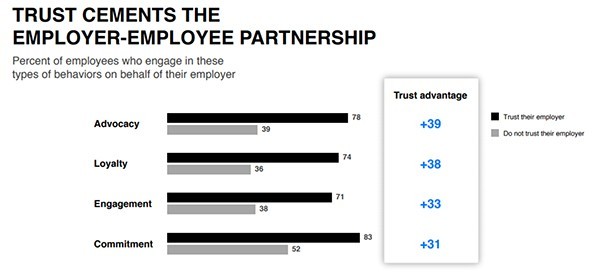Leadership and Employee Engagement are Linchpins for Trust in 2019
The best ways to build trust with your customers are through honesty, transparency, and quality. Delivering on these fronts should be a key priority for businesses everywhere today, and usually is. But research suggests there are two trust-building factors that brands might be overlooking.
To the outside world, an organization’s employees and business leaders are critical indicators of its trustworthiness. Are you sending the right signals?
Trust is a Must
Each year, Edelman releases a “Trust Barometer” report designed to gauge the public’s feelings of trust toward four institutions: Business, Government, Media, and NGOs. Edelman’s most recent 2019 edition showed positive progress, with 54% of respondents in the United States expressing trust toward businesses, compared to 48% in 2018.
That latest number still isn’t great, of course. And the stakes are high, because trust is increasingly becoming one of the biggest differentiators for brands. There are any number of stats out there to support this, including this one: in a study last year by SurveyMonkey, 65% of people said that trust in a brand has “a lot” or “a great deal” of influence on their purchase decisions. Additionally, in the 2019 Trust Barometer, two out of three respondents agreed that “a good reputation may get me to try a product, but unless I come to trust the company behind the product, I will soon stop buying it.”
As Bill McDermott, CEO of SAP, has put it: “Trust is the ultimate human currency. It's earned in drops, lost in buckets.”
So, how can brands raise this essential watermark and avoid springing leaks? Instead of looking outward, we should perhaps first look inward.
Happy and Engaged Employees Are Vital to Your Brand’s Perception
Edelman’s 2019 Trust Barometer finds 78% of people agreeing with this statement: “How a company treats its employees is one of the best indicators of its level of trustworthiness.” Naturally, we should all be striving to treat our employees well, but this data point suggests it is also advantageous to publicize and amplify our strengths in this department.
There are steps that marketers can take to nurture this image. For example, loading up the Life tab on your organization’s LinkedIn Page with content and visuals illustrating your company culture, or posting updates on your Page that highlight employee achievements, or creating “Day in the Life” videos, are among the many ways to bolster this initiative.
But ultimately, nothing outwardly conveys the appearance of happy and invested employees better than the employees themselves. And Edelman’s data suggests that behaviors like advocacy, engagement commitment, and loyalty are all largely shaped by the level of trust these individuals feel toward their employers:
(Source: 2019 Edelman Trust Barometer)
Based on these findings, it seems fair to say that building trust with your employees is a critical step toward building trust with your audience at large.
Business Leaders Set the Tone for Trust-Building
According to the 2019 Trust Barometer, 71% of employees agree that “It’s critically important for my CEO to respond to challenging times,” which can include industry issues, political events, national crises, and employee-driven issues. In other words, they want their leaders to speak up and take a stand.
“Our data shows that CEOs who take a stand on values that pertain to the company they represent win on trust,” says Kylie Wright-Ford, CEO of the Reputation Institute. “CEO success is no longer based purely on financial returns. I won’t ever say ROI isn’t critical, but to be relevant as a contemporary leader, CEOs must have a conscience and stand for something with a higher purpose.”
What this looks like will obviously change based on the brand, industry, and people in question. But every company should have a defining purpose that runs deeper than dollars and cents, and execs (not just CEOs) can continually reinforce the values they wish to be known for through strong and consistent thought leadership. When done right, this will help build trust with both employees and customers.
Takeaways on Marketing Trust in 2019
Since we know that trust is a major factor in brand reputation, it needs to be at the center of marketers’ radars. And while infusing honesty, transparency, and quality throughout our content and customer interactions will undoubtedly be helpful, the data we’ve shared here shows that this directive should run deeper through an organization. Here are a few recommended actions:
- Showcase your company culture in the Life tab on your LinkedIn Page
- Empower employees to become advocates (a dedicated platform like LinkedIn Elevate can help)
- Keep your team engaged through transparency and open communications
- Encourage company leaders to be outspoken on topics and issues that are important to your employees and customers (longform publishing on LinkedIn can be a great avenue)
There’s a powerful domino effect that takes place when strong trust is fostered internally within your organization. This can translate to the way employees advocate for and talk about your brand in their own circles, which then reflects in the eyes of customers.
A strategy that emphasizes marketing trust needs to account for this dynamic.
To stay up on the latest insights and guidance to develop lasting relationships with your customers, subscribe to the LinkedIn Marketing Blog.








